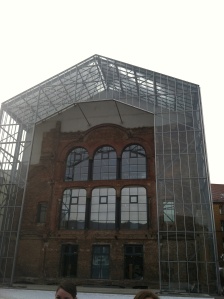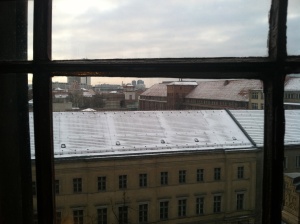After an early morning wake-up and a quick breakfast, we were headed out for a long day—starting with a visit to, and tour of, the headquarters and prison complex of the former East German secret police, known as Stasi. Upon arriving to Hohenschonhausen (its official name), our group (minus a few who had stayed behind due to illness) was greeted by Mr. Hans Scheidler, our tour guide. The tour given by the Hohenschonhausen museum was rather unique compared to any of the others we’ve experienced for one specific reason: our guide, and almost every guide the museum employs, was previously incarcerated at the Stasi prison. However, Mr. Scheidler did not reveal his “crime” to us right away, preferring to keep it secret until he saw fit.
As the tour progressed, we saw former Stasi office and administrative buildings, the area where prisoners were first unloaded, two prison cell blocks, and finally the interrogation rooms. Mr. Scheidler basically guided us through how new prisoners were processed at Hohenschonhausen: first the unloading room, then to be strip searched and have your belongings confiscated, and eventually you would be put into a cell. His own experience was that of solitary confinement, which he endured for months until he feigned a suicide attempt to escape the loneliness.
Following the end of World War II when the defeated Germany was divided by the victorious allies, the newly formed Soviet government in the eastern half of Berlin established the Stasi secret police to keep tabs on their new society. Anyone and everyone were spied upon in various ways—families and neighbors and coworkers would report any action they thought was treasonous. In turn, the Stasi recorded this information (along with a bevy of other extremely personal bits of information) with the possible intention of using it to arrest you later on. Though during this time, one could be arrested for simply bad-mouthing the government or showing any small sign of protest—which is what Mr. Scheidler had done. Once we reached the interrogation rooms within the complex, he decided to tell us of his “heinous” crime. Upon hearing of the invasion of Czechoslovakia by the Soviet Union in 1968, the young Scheidler and a few of his college friends decided to create a bunch of leaflets in protest which said the following:
“Citizens- Comrades. Foreign tanks in Czechoslovakia only serve the class enemy. Think about the reputation of Socialism in the world. Demand truthful information. Nobody is too stupid to think for themselves.”
For this simple act, he and his friends were given prison sentences at Hohenschonhausen. For a year and a half, Mr. Scheidler lived within the confines of the horrid place he now frequently returned to. In the beginning, he told us, he couldn’t stand to talk about his experience but was always haunted by the memories. Only after he decided to give tours for the museum did he actually come to terms with the past, which was quite uplifting to hear. As he sat in the interrogator’s chair, finally on the opposite side of where he had once been, the sheer power of his story of survival during a time of great injustice became awe-inspiring.
When we finished at Hohnenschoenhausen, we made our way to the DDR museum where we enjoyed a lunch of popular dishes from the former east. A couple of us were brave and tried the DDR version of coke, an interesting mixture of lemon flavoring and flat cola. Needless to say, it wasn’t a big hit. After lunch, we went on a tour of the museum, but this tour was different from any other tour we had been on since we got to Europe because it was interactive. We were actually able to touch things on display and open drawers and see real versions of popular toys, clothes, and common household items. We were also able to see a pair of the denim knock off 501 Levi’s jeans that were popular in the east. The east version was made with a lovely plaid pattern that we couldn’t seem to get over. Our tour guide explained to us that those were the jeans everyone wore unless you were lucky enough to have a relative in the west that was willing to send you a pair of real 501’s, a pair without plaid. But if you dared wear them to school your teacher would pull you aside and say how you shouldn’t be wearing “Socialist product” and instruct you to go change. So the daily ritual of leaving the house in normal jeans changing into a plaid pair for school and back into normal ones after you left to go home became routine for young kids of the east.
After exploring the museum and our little fashion history lesson we had a question and answer session with the director of the DDR museum, Mr. Stefan Wolle. Mr. Wolle discussed with us what life behind the wall was like as well as anti-Semitism in the former East. Talking with him gave us a completely different view of what life was like in the east in comparison to the version we had received earlier in the day at Hohenschoenhausen. He explained that people in the east had normal lives: they went to work, got married, had kids, did everything people in the west did. He told us that when the wall fell, everything for easterners changed. Top nurses who had been assisting surgeons in complex surgeries for years now had to start on the bottom and go through all sorts of school and training just because they were from the east, therefore making their former education inadequate. He discussed how any thoughts or ideas that came from the east were considered bad and invalid when met with their western counterparts.
Today we were able to see two completely different versions of the same situation and it was very interesting to be able to compare them. On one side, people said that nothing positive ever came from the East and that it was just a completely terrible awful place and on the other side the point was made that people lived as normal of lives as anyone else. So really, when you think about it, it all comes down to perspective and the pair of lenses you select for yourself when looking at a situation that has more than enough evidence to support of both sides of the argument.





